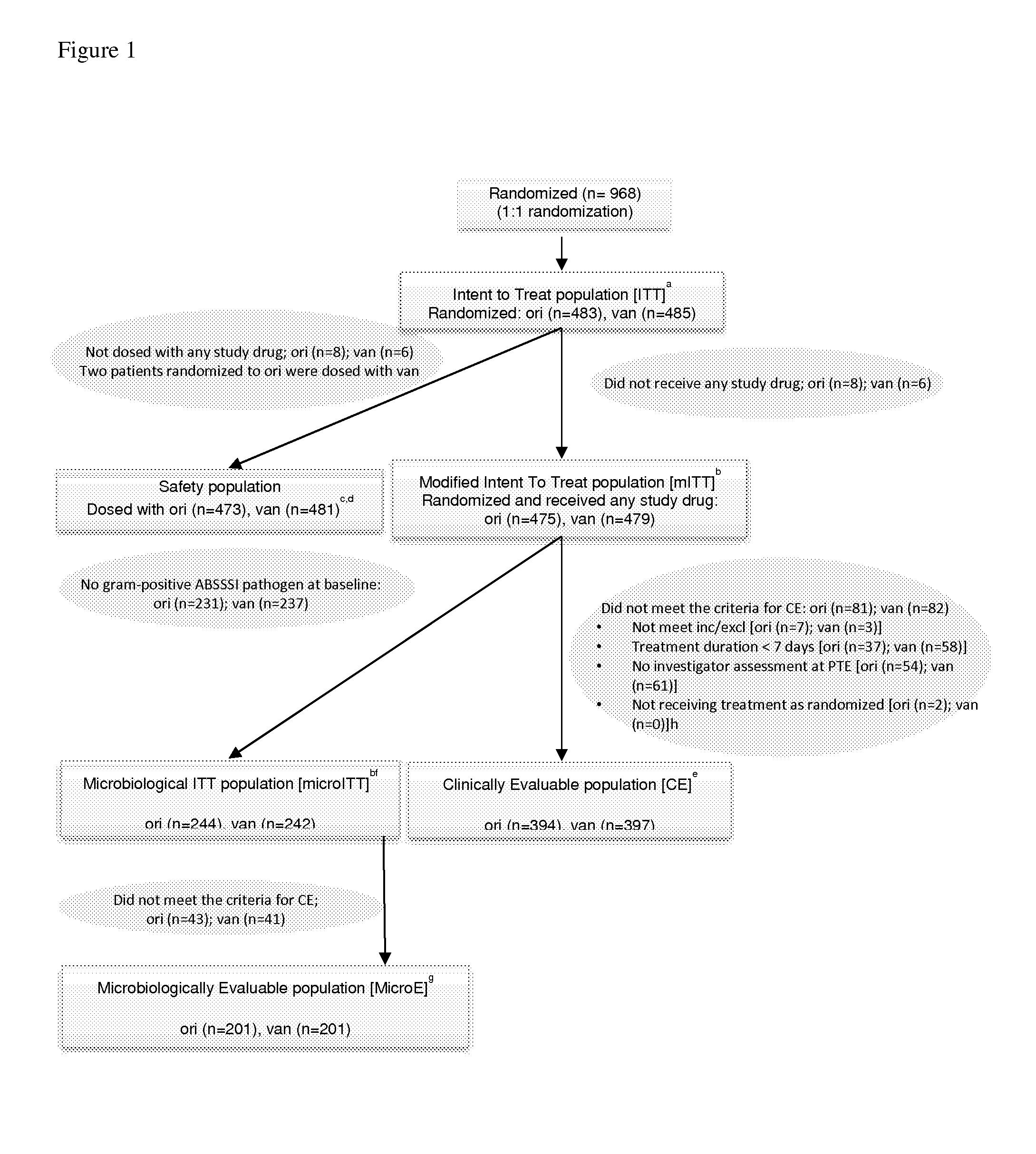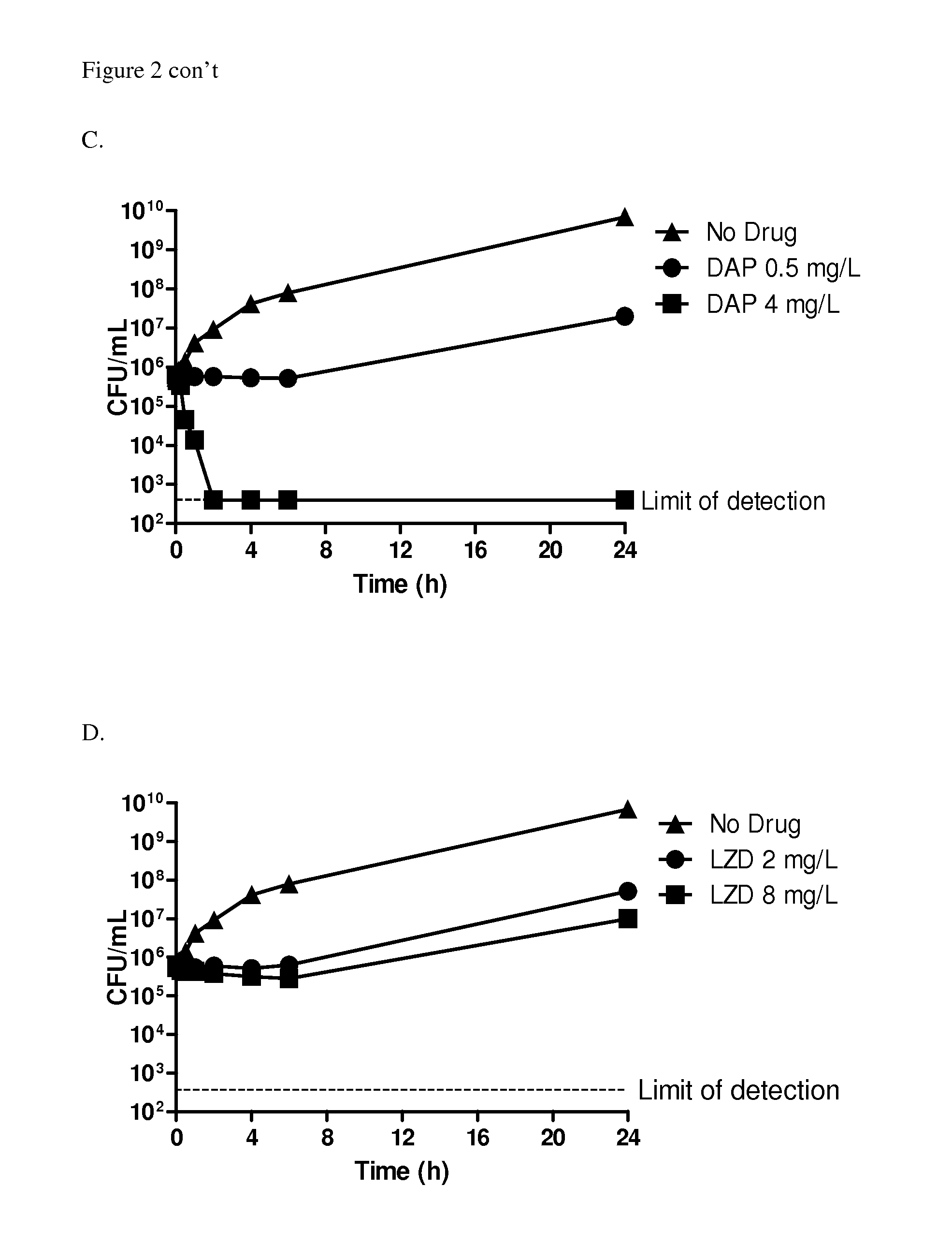Treatment and prevention of bacterial skin infections using oritavancin
a glycopeptide, skin infection technology, applied in the direction of antibacterial agents, peptide/protein ingredients, drug compositions, etc., can solve the problems of high cost and inconvenience of multiple administrations of abssi treatment, and achieve the effect of treating or preventing a bacterial skin infection
- Summary
- Abstract
- Description
- Claims
- Application Information
AI Technical Summary
Benefits of technology
Problems solved by technology
Method used
Image
Examples
example 1
Summary
[0115]Oritavancin is a lipoglycopeptide with rapid bactericidal activity against gram-positive bacteria including methicillin-resistant Staphylococcus aureus (MRSA). Oritavancin's concentration-dependent activity and long half-life allows for single dose administration that may provide better compliance and favourable efficacy and safety outcomes.
[0116]Adults with acute bacterial skin and skin structure infections (ABSSSI) requiring IV therapy received a single 1200 mg dose of oritavancin or vancomycin for 7 to 10 days. The primary efficacy endpoint comprised: 1) cessation of spreading or reduction in the size of the baseline lesion, 2) absence of fever, and 3) no rescue antibiotic, at 48 to 72 hours, for the modified intent to treat population.
[0117]Of 968 patients randomized in the study, 475 and 479 were included in the modified intent-to-treat population for oritavancin and vancomycin, respectively. At 48 to 72 hours, both the early clinical evaluation response rate for o...
example 2
Summary
[0168]Serious infections caused by methicillin-resistant Staphylococcus aureus (MRSA) have been documented both in healthcare and community settings, and continue to be problematic in healthcare systems. Traditionally, MRSA isolates are positively identified by amplification of a portion of the mecA gene (CLSI, 2012a). Recently, isolates which are phenotypically resistant to methicillin but which are mecA amplification-negative have been described (Garcia-Alvarez et al., 2011). Further analysis of some of these strains indicated that they harbour a novel mec gene which is only ˜70% homologous to the mecA gene. This gene has been designated the mecC gene (Ito et al., 2012) and has been shown to be present in zoonotic MRSA isolates (Petersen et al., 2012). This study evaluated the activity of oritavancin and comparators against 14 mecC-carrying MRSA strains obtained from skin and skin structure infections by broth microdilution MIC and time-kill assays at clinically-relevant co...
example 3
[0180]A clinical trial (SOLO II) was found to meet all protocol-specified endpoints comparing one single intravenous dose of oritavancin to twice-daily vancomycin intravenous dosing for 7-10 days. Pooled data from two clinical trials (SOLO I and SOLO II) in MRSA showed a higher proportion of oritavancin patients achieved the endpoint of >=20% reduction of lesion area at 48-72 hours.
[0181]Complete results were obtained from a phase 3 clinical trial program of oritavancin (SOLO), which investigated the drug for the treatment of acute bacterial skin and skin structure infections (ABSSSI) caused by susceptible gram-positive bacteria, including methicillin-resistant Staphylococcus aureus (MRSA). SOLO I and SOLO II clinical trials were identical multicenter, double-blind, randomized clinical trials.
[0182]In SOLO II, all protocol-specified primary and secondary efficacy endpoints were met. Oritavancin was shown to be non-inferior to vancomycin in the efficacy analyses for the Early Clinica...
PUM
| Property | Measurement | Unit |
|---|---|---|
| surface area | aaaaa | aaaaa |
| temperature | aaaaa | aaaaa |
| width | aaaaa | aaaaa |
Abstract
Description
Claims
Application Information
 Login to View More
Login to View More - R&D
- Intellectual Property
- Life Sciences
- Materials
- Tech Scout
- Unparalleled Data Quality
- Higher Quality Content
- 60% Fewer Hallucinations
Browse by: Latest US Patents, China's latest patents, Technical Efficacy Thesaurus, Application Domain, Technology Topic, Popular Technical Reports.
© 2025 PatSnap. All rights reserved.Legal|Privacy policy|Modern Slavery Act Transparency Statement|Sitemap|About US| Contact US: help@patsnap.com



